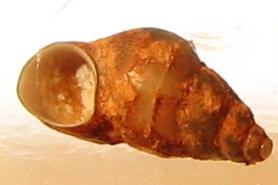New Zealand mudsnail
(Potamopyrgus antipodarum)
The New Zealand mudsnail was first discovered in the middle of the Snake River in Idaho in 1987. Since its discovery, the New Zealand mudsnail has spread throughout the western U.S. and the U.S. Great Lakes. The New Zealand mudsnail is a nocturnal grazer, feeding on sediments and algae. containing phytoplankton and zooplankton.
Other names for this plant include:
- Common names: New Zealand mudsnail
- Scientific names: Potamopyrgus antipodarum
Classification in Wisconsin: Prohibited
- Ecological Threat
-
The New Zealand mudsnail is a small, operculate (trapdoor) snail that gives birth to live young. It is a primary consumer that grazes on algae and is native New Zealand. The New Zealand mudsnail has a wide range of environmental tolerances and has been found in nearly every freshwater habitat in New Zealand. In their native habitat they are known to reproduce sexually; however, they can reproduce asexually and all introduced populations are clonal. This means that only one snail is needed to start a new population.
Effects at the the Black Earth Creek fisheryIt is unknown how the mudsnail will affect the Black Earth Creek fishery as this is the first inland invasion not only in Wisconsin, but in the Midwest. Research from other invasion sites, however, suggests that Wisconsin streams could realize negative impacts. The New Zealand mudsnails will likely compete directly with many native grazers and could reduce the abundance of this important food source. Research from the western U.S. also suggests that some fish (brown trout and sculpin) avoid mudsnails while some fish (mountain whitefish) will readily eat them. However, energetic studies show that New Zealand mudsnails can pass through fish stomachs undigested and therefore may offer little to no energy when compared to other common food items. New Zealand mudsnails do have predators in their native range, but there is no evidence that predators do or could control populations.
New Zealand mudsnail spreadDue to its small size, the New Zealand mudsnail can easily hitchhike on a variety of recreational and commercial equipment that comes in contact with the water and riparian zone. Its operculum allows it to survive in undesirable environments for extended periods of time. Initial invasion pathways to the United States are thought to have been through ballast water or in the water of live game fish shipped from infested waters. Many other pathways may contribute to the secondary spread of New Zealand mudsnails. These pathways include but are not limited to waders and other fishing gear, watercraft, commercial construction equipment and fish stocking equipment.
- Identification
-
The New Zealand mudsnail has a dextral (right-handed coiling), elongated shell with seven to eight whorls (twirls) separated by deep grooves. The shell color can range from gray to light or dark brown. In the Great Lakes the New Zealand mudsnail typically measures four to six mm in length, but grows to 12 mm regularly in its native range.
- Distribution
-
In the fall of 2013, the New Zealand mudsnail was discovered in benthic macroinvertebrate samples collected from Black Earth Creek in western Dane County in 2011 and 2012. The only other populations in the region are in Lake Superior’s Duluth-Superior Harbor and Lake Michigan’s Waukegan Harbor. These populations have not been observed to be expanding. The extent of New Zealand mudsnail invasion in southwest Wisconsin is currently unknown, but the department will continue monitoring to define the distribution of New Zealand mudsnail in Wisconsin. Most of Wisconsin's streams are free of many aquatic invasive species, including New Zealand mudsnail, and preventative actions can keep these streams free of invasive species and their potentially negative impacts.
See the reported locations of this species in Wisconsin on the Aquatic Species Tracking pages. If you know of a location that is not listed, send us a report.
- Control
-
Mechanical: There are no mechanical methods that will eradicate a New Zealand mudsnail population.
Chemical: There is no chemical that can be used to kill New Zealand mudsnails in a stream without killing all other species.
Prevention: Wisconsin’s invasive species law prohibits the transport of aquatic plants, live animals and water from a waterbody, with some exceptions for bait. However, simple hand removal may not be enough to remove New Zealand mudsnails. They are easily transported and harder to kill than many invasives we have dealt with in the past. Several effective methods to prevent their spread have been identified. The following guidelines work for both boating and wading equipment:
BEFORE leaving the water- INSPECT equipment and REMOVE attached plants and animals (required by law).
- DRAIN all water from equipment (required by law).
- SCRUB equipment with a stiff brush, including crevices, to remove all mud and snails.
- RINSE equipment with tap water to remove juveniles. Consider keeping a water jug or spray bottle in your car.
- FREEZE for eight hours, or
- WASH with 212°F water (steam clean), or
- SOAK in 120°F water for several minutes, or
- SOAK in 2% Virkon solution (2.7 ounces per gallon) for 20 minutes
- Do not use felt-soled boots. They are more likely to harbor small-bodied aquatic invasives and are very difficult to decontaminate completely.
- Consider having a second pair of waders or boots if it may not be practical to clean your waders when moving from one stream to another.
- If visiting multiple sites along the length of a stream or river, begin at the top of the watershed and work your way downstream.
- Gear decontamination research is ongoing. Check with state resource agencies and conservation groups for new methods as they become available.
- Complete drying of equipment can kill New Zealand mudsnails, but high temperatures are needed. Research shows at least 24 hours at 84°F or at least two hours at 104°F are effective. Drying is not effective for felt soled boots or other porous materials that remain damp, since New Zealand mudsnails can survive in damp environments for weeks.
- There are several papers that look at the use of Formula 409 cleaner to kill the snails. However, because there are different formulas and the amounts needed are large, this is not an effective method to recommend to the public at this time.
- Diluted bleach has not been shown to be effective in killing New Zealand mudsnails.
- Resources
- Sources for content:


